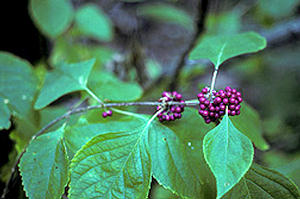February 2, 2006
Bug Off
Interesting -- folk remedies come through again. From the USDA Agricultural Research Service:Learning from our eldersVery cool -- as anyone who has used DEET, an alternative would be really nice. DEET stings the eyes, tastes really bad and doesn't really stay on the skin. It works but it is a pain to deal with. It just happens to be less of a pain than dealing with skeeters. They are doing tox trials now so it will be a year or two more but, this will be something to watch for. Or just find a source for Callicarpa americana -- nice looking shrub:
Folk Remedy Yields Mosquito-Thwarting Compound
Regional wisdom once imparted by a Mississippi grandfather has led ARS scientists to isolate a natural compound that in laboratory tests was effective in warding off mosquito bites.
The efficacy of the isolated compound—called “callicarpenal”—was affirmed through tests simulating human skin. But these results may not have been a surprise in northeastern Mississippi as long as a century ago, once the source of the callicarpenal was revealed.
Seems that it was known there that fresh, crushed leaves of American beautyberry, Callicarpa americana, in the family Verbenaceae, helped keep biting insects away from animals such as horses and mules. Placing crushed beautyberry leaves under the animals’ harnesses, residents knew, would mash out a repellent oil. Eventually, some folks there took to mashing the leaves and rubbing the residue on their own skins.
Privy to this knowledge was young Charles T. Bryson, who was told about it by his granddad, John Rives Crumpton.
Today, Bryson is a botanist in ARS’s Southern Weed Science Research Unit at Stoneville, Mississippi. And he’s told researchers in ARS’s Natural Products Utilization Unit at Oxford, Mississippi, about beautyberry’s powers.
This led Oxford chemist Charles Cantrell—with entomologist Jerome Klun of ARS’s Chemicals Affecting Insect Behavior Research Laboratory in Beltsville, Maryland, and Oxford plant physiologist Stephen Duke—to isolate from American beautyberry and a Japanese counterpart, C. japonica, five insect-repelling compounds.
Among them was callicarpenal, which may represent ARS’s next important contribution against mosquitoes. ARS developed—and USDA patented in 2003—SS220, a repellent that’s just as effective as DEET.

Comments
Post a comment